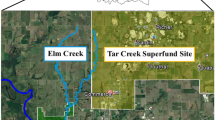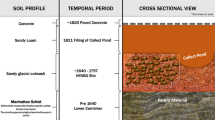Abstract
Purpose
Copper (Cu) is the earliest anthropogenic metal pollutant, but knowledge of Cu soil concentrations at ancient metalworking sites is limited. The objective of this work was to examine the ability of portable X-ray fluorescence to quantify Cu in soils at such sites.
Materials and methods
Using a Bruker Tracer III-SD pXRF, we examine factory “scan” settings versus simple instrument parameter changes (a reduction in energy settings from 40 to 12 kV) to target analysis for Cu. We apply these to a set of uncontaminated samples (n = 18, < 92 mg Cu kg−1) from Central Thailand and compare results to standard wet chemistry analysis (aqua regia digestion and ICP-OES analysis). We then apply the optimized method to a set of highly contaminated samples (n = 86, < 14,200 mg Cu kg−1) from a known ancient smelting site.
Results and discussion
We demonstrate that simple changes to factory recommended “scan” settings can double the sensitivity of Cu determination via pXRF (“optimized limit of determination” of 19.3 mg kg−1 versus an initial value of 39.4 mg kg−1) and dramatically improve the accuracy of analysis. Changes to other results for other elements are variable and depend on concentration ranges, soil matrix effects, and pXRF response for the individual element. We demonstrate that pXRF can accurately determine Cu across a wide concentration range and identify grossly contaminated soil samples.
Conclusions
We conclude that pXRF is a useful tool to rapidly screen and analyse samples at remote sites and can be applied to ancient metalworking sites. Simple optimization of the pXRF settings greatly improves accuracy and is essential in determining comparative background concentrations and “unaffected” areas. Application to other elements requires further element and matrix specific optimization.



Similar content being viewed by others
References
Bruker AXS Handheld Inc (2006) Tracer III-V manual. Bruker AXS Handheld Incorporated, Kennewick
Ciarla R (2007) A preliminary report on Lo.R.A.P. Archaeological Excavations at Prehistoric Khao Sai On, Lopburi Province, Central Thailand. East West 57:395–401
Dudal R, Moorman FR (1964) Major soils of Southeast Asia. J Tropic Geograph 18:54–80
Fanti F, Bell PR, Tighe M, Milan LA, Dinelli E (2018) Geochemical fingerprinting as a tool for repatriating poached dinosaur fossils in Mongolia: a case study for the Nemegt Locality, Gobi Desert. Palaeogeogr Palaeoclimatol Palaeoecol 494:51–64. https://doi.org/10.1016/j.palaeo.2017.10.032
Forster N, Grave P (2012) Non-destructive PXRF analysis of museum-curated obsidian from the near east. J Archaeol Sci 39:728–736
Grattan JP, Gilbertson DD, Waller JH, Adams RB (2014) The geoarchaeology of “waste heaps” from the ancient mining and beneficiation of copper-rich ores in the Wadi Khalid in southern Jordan. J Archaeol Sci 46:428–433. https://doi.org/10.1016/j.jas.2013.08.001
Grattan JP, Adams RB, Friedman H, Gilbertson DD, Haylock KI, Hunt CO, Kent M (2016) The first polluted river? Repeated copper contamination of fluvial sediments associated with Late Neolithic human activity in southern Jordan. Sci Total Environ 573:247–257
Grave P, Attenbrow V, Sutherland L, Pogson R, Forster N (2012) Non-destructive pXRF of mafic stone tools. J Archaeol Sci 39:1674–1686
Homsher RS, Tepper Y, Drake BL, Adams MJ, David J (2016) From the Bronze Age to the “Lead Age”: observations on sediment analysis at two archaeological sites in the Jezreel Valley, Israel. Mediterranean Archaeology and Archaeometry 16:203–220
Horta A, Malone B, Stockmann U, Minasny B, Bishop TFA, McBratney AB, Pallasser R, Pozza L (2015) Potential of integrated field spectroscopy and spatial analysis for enhanced assessment of soil contamination: a prospective review. Geoderma 241–242:180–209
Hunt AMW, Speakman RJ (2015) Portable XRF analysis of archaeological sediments and ceramics. J Archaeol Sci 53:628–638
IUSS Working Group WRB (2015) World Reference Base for Soil Resources 2014, update 2015 International soil classification system for naming soils and creating legends for soil maps. FAO, Rome
Kabata-Pendias A, Szteke B (2015) Chapter 14. Copper. In: Trace elements in abiotic and biotic environments. CRC Press, Boca Raton, pp 97–105
McLaren TI, Guppy CN, Tighe MK, Forster N, Grave P, Lisle LM, Bennett JW (2012) Rapid, nondestructive total elemental analysis of vertisol soils using portable X-ray fluorescence. Soil Sci Soc Am J 76:1436
Mighall TM, Timberlake S, Clark SHE, Caseldine AE (2002) A palaeoenvironmental investigation of sediments from the prehistoric mine of Copa Hill, Cwmystwyth, mid-Wales. J Archaeol Sci 29:1161–1188
Milestone (2009) Application note 031: soil particle digestion. http://www.milestonesci.com/index.php/resources/resources/finish/164/969.html. Accessed 15 Feb. 2016
Mulvey PJ, Elliott GL (2007) 13.6 toxicities in soils. In: Charman PEV, Murphy BW (eds) Soils: their properties and management. Oxford University Press, Melbourne
NEPC (2013a) National Environmental Protection (assessment of site contamination) measure. In: National Environmental Protection Council. Canberra, Australia
NEPC (2013b) Schedule B(1) Guideline on investigation levels for soil and groundwater National Environmental Protection Council, Canberra, Australia
Nriagu JO (1996) A history of global metal pollution. Science 272:223–224
Pinheiro J, Bates D, S DebRoy, Sarkar D, R Core Team (2014) nlme: linear and nonlinear mixed effects models. R package version 3.1–117, https://CRAN.R-project.org/package=nlme
Pryce TO, Pigott VC, Martinón-Torres M, Rehren T (2010) Prehistoric copper production and technological reproduction in the Khao Wong Prachan Valley of Central Thailand. Archaeol Anthropol Sci 2:237–264
R Core Team (2014) R: a language and environment for statistical computing. R Foundation for Statistical Computing. http://www.R-project.org/, Vienna, Austria
Rispoli F, Ciarla R, Pigott VC (2013) Establishing the prehistoric cultural sequence for the Lopburi Region, Central Thailand. J World Prehist 26:101–171
Rouillon M, Taylor MP (2016) Can field portable X-ray fluorescence (pXRF) produce high quality data for application in environmental contamination research? Environ Pollut 214:255–264
Rousseau RM (2001) Detection limit and estimate of uncertainty of analytical XRF results. Rigaku J 18:33–47
Soil Survey Division Kingdom of Thailand (1974) Detailed Reconnaisance Soil Map of Lop Buri Province. 1:100000. Sheets IV-VII. Soil Survey Division, Bangkok, Thailand
Soil Survey Staff (1999) Soil taxonomy: a basic system of soil classification for making and interpreting soil surveys. 2nd edition Natural Resources Conservation Service. U.S. Department of Agriculture Handbook
Tighe M, Forster N (2013) Rapid, nondestructive elemental analysis of tree and shrub litter. Commun Soil Sci Plant Anal 45:53–60
Tighe M, Lockwood P, Wilson S, Lisle L (2004) Comparison of digestion methods for ICP-OES analysis of a wide range of analytes in heavy metal contaminated soil samples with specific reference to arsenic and antimony. Commun Soil Sci Plant Anal 35:1369–1385
Tighe M, Forster N, Guppy C, Savage D, Grave P, Young IM (2018a) Georeferenced soil provenancing with digital signatures. Sci Rep 8:3162. https://doi.org/10.1038/s41598-018-21530-7
Tighe M, Rogan G, Wilson SC, Grave P, Kealhofer L, Yukongdi P (2018b) The potential for portable X-ray fluorescence determination of soil copper at ancient metallurgy sites, and considerations beyond measurements of total concentrations. J Environ Manag 206:373–382
Tóth G, Hermann T, Da Silva MR, Montanarella L (2016) Heavy metals in agricultural soils of the European Union with implications for food safety. Environ Int 88:299–309
US Environmental Protection Agency (2007) In: US Environmental Protection Agency (ed) Method 6200: field portable X-ray fluorescence spectrometry for the determination of elemental concentrations in soil and sediment, Washington, DC
Weindorf DC, Chakraborty S (2016) Portable X-ray fluorescence spectrometry analysis of soils. Method Soil Anal 1:1–8
Weindorf DC, Bakr N, Zhu Y (2014) Advances in portable X-ray fluorescence (PXRF) for environmental, pedologial, and agronomic applications. In: Sparks DL (ed) Advances in agronomy, vol 128. Academic Press, San Diego, pp 1–45
Zarcinas BA, Pongsakul P, McLaughlin MJ, Cozens G (2004) Heavy metals in soils and crops in Southeast Asia. 2. Thailand. Environ Geochem Health 26:359–371
Acknowledgements
This work was undertaken as part of a University of New England Research Seed Grant, and within an approved National Research Council of Thailand project (approval number 0002/1211). The authors would like to thank Dr. Fiorella Rispoli and Dr. Roberto Ciarla for site information and background, and Dr. Vince Piggott for discussions and project context.
Author information
Authors and Affiliations
Corresponding author
Additional information
Responsible editor: Dong-Mei Zhou
Electronic supplementary material
ESM 1
(DOCX 1923 kb)
Rights and permissions
About this article
Cite this article
Rogan, G., Tighe, M., Grave, P. et al. Optimization of portable X-ray fluorescence spectrometry for the assessment of soil total copper concentrations: application at an ancient smelting site. J Soils Sediments 19, 830–839 (2019). https://doi.org/10.1007/s11368-018-2091-3
Received:
Accepted:
Published:
Issue Date:
DOI: https://doi.org/10.1007/s11368-018-2091-3




